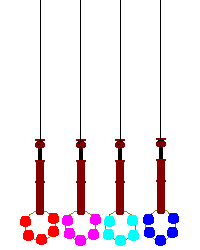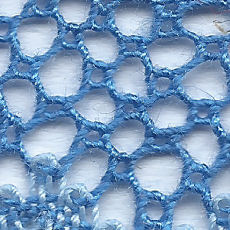



|
|
Working: half stitch and twist, pin, half stitch and twist
Twisted hole ground is used in Spanish lace, where it is known as punto monja (nun point), punto de perdiz (partridge point) or trena vella (Catalan for "old braid"). This ground was described to me by a Spanish speaker as T T C, but that is equivalent to C T T for those of us who start stitches with a cross rather than a twist. A variant of this ground adds an extra twist.
The Dutch for this stitch is Gesloten speldslag. The Italian is maglia di Spagna or mesh of Spain. Other English terms are twisted half stitch or Spanish ground. In Denmark (Tønder lace) they call it "pearl ground" because of the tiny "pearls" where the pin is.

The hole is more dominant in this ground than Torchon ground. See pattern 297.

Traditionally, these simple grounds are shown as dots. I prefer marking in where the pairs go.
The basic stitch for this ground, half stitch and twist, pin, half stitch and twist, is the same as used in honeycomb. The difference is that twisted hole ground has a simple pattern of tilted squares, the same as Torchon ground, while honeycomb has a more complicated pattern, with triangles and hexagons.
Twisted hole ground can be loose at the pin, making too big a hole. After making the stitch after the pin (closing the pin), first pull the outer bobbins downwards (which widens the hole, but pulls out any slack above the pin), then pull the inner bobbins downwards (which tightens the hole).
© Jo Edkins 2017 - return to lace index